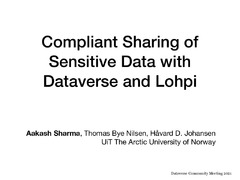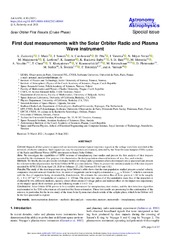Fakultet for naturvitenskap og teknologi: Nye registreringer
Viser treff 1961-1980 av 5334
-
Preliminary Hazard Analysis for UAV-assisted Bridge Inspection
(Journal article; Tidsskriftartikkel; Peer reviewed, 2020)Unmanned aerial vehicle (UAV) technology has found its way into a number of civilian applications in the last 20 years, predominantly due to lower costs and tangible scientific improvements. In its application to structural bridge inspection, UAVs provide two main functions. The first, being the most common, detects damage through visual sensors. The 2D imagery data can be used to quickly ... -
Compliant Sharing of Sensitive Data with Dataverse and Lohpi
(Conference object; Konferansebidrag, 2021-06) -
Up-to-the-minute Data Policy Updates for Participatory Studies
(Conference object; Konferansebidrag, 2021-06-14) -
Privacy Perceptions and Concerns in Image-Based Dietary Assessment Systems: Questionnaire-Based Study
(Journal article; Tidsskriftartikkel; Peer reviewed, 2020-10-15)Background: Complying with individual privacy perceptions is essential when processing personal information for research. Our specific research area is performance development of elite athletes, wherein nutritional aspects are important. Before adopting new automated tools that capture such data, it is crucial to understand and address the privacy concerns of the research subjects that are to be ... -
Anti-proliferative activity of a novel tricyclic triterpenoid acid from Commiphora africana resin against four human cancer cell lines
(Journal article; Tidsskriftartikkel; Peer reviewed, 2020-03-17)Myrrh, a resin derived from the damaged bark of Commiphora genus, has traditionally been used for treatment of various human diseases, such as amenorrhea, ache, tumors, fever, and stomach pains. In spite of this widespread use of the myrrh in Ethiopia, the pharmacological activity and chemical composition have not been studied in detail. A new tricyclic triterpene acid (3S,4S,14S,7E,17E,21Z)-3, ... -
Machine Learning-based Classification, Detection, and Segmentation of Medical Images
(Doctoral thesis; Doktorgradsavhandling, 2022-01-21)Gastrointestinal tract (GI) cancers are among the most common types of cancers worldwide. In particular, colorectal cancer (CRC) is the most lethal in terms of number of incidences and mortality (third most common cause of cancer and the second common cause of cancer-related deaths). Colonoscopy is the gold standard for screening patients for CRC. During the colonoscopy, gastroenterologists examine ... -
High spatial and temporal resolution L- and C-band Synthetic Aperture Radar data analysis from the yearlong MOSAiC expedition
(Conference object; Konferansebidrag, 2021-04)In the yearlong MOSAIC expedition (2019-2020) R/V Polarstern drifted with sea ice through the Arctic Ocean, with the goal to continually monitor changes in the coupled ocean-ice-atmosphere system throughout the seasons. A substantial amount of synthetic aperture radar (SAR) satellite images overlapping the campaign was collected. Here, we investigate the change in polarimetric features over sea ice ... -
The Structure of Climate Variability Across Scales
(Journal article; Tidsskriftartikkel; Peer reviewed, 2020-03-05)One of the most intriguing facets of the climate system is that it exhibits variability across all temporal and spatial scales; pronounced examples are temperature and precipitation. The structure of this variability, however, is not arbitrary. Over certain spatial and temporal ranges, it can be described by scaling relationships in the form of power laws in probability density distributions and ... -
First dust measurements with the Solar Orbiter Radio and plasma wave instrument
(Journal article; Tidsskriftartikkel; Peer reviewed, 2021-12-14)Context - Impacts of dust grains on spacecraft are known to produce typical impulsive signals in the voltage waveform recorded at the terminals of electric antennas. Such signals (as may be expected) are routinely detected by the Time Domain Sampler (TDS) system of the Radio and Plasma Waves (RPW) instrument on board Solar Orbiter.<p> <p>Aims - We investigate the capabilities of RPW in terms of ... -
Dynamics of nanodust in the vicinity of a stellar corona: Effect of plasma corotation
(Journal article; Tidsskriftartikkel; Peer reviewed, 2021-08-24)Context - In the vicinity of the Sun or other stars, the motion of the coronal and stellar wind plasma must include some amount of corotation, which could affect the dynamics of charged dust particles. In the case of the Sun, this region is now investigated in situ by the Parker Solar Probe. Charged dust particles coming from the vicinity of the Sun can also reach, and possibly be detected by, ... -
Regional Morpho-Kinematic Inventory of Slope Movements in Northern Norway
(Journal article; Tidsskriftartikkel; Peer reviewed, 2021-11-25)Mountain slopes in periglacial environments are affected by frost- and gravity-driven processes that shape the landscape. Both rock glaciers and rockslides have been intensively inventoried worldwide. Although most inventories are traditionally based on morphologic criteria, kinematic approaches based on satellite remote sensing have more recently been used to identify moving landforms at the regional ... -
Recoverability modeling of power distribution systems using accelerated life models: Case of power cut due to extreme weather events in Norway
(Journal article; Tidsskriftartikkel; Peer reviewed, 2020-07-09)Today’s societies rely on electric power distribution systems. Recent weather events have illustrated that the loss of such service can lead to severe consequences for societies and stakeholders. Hence, to reduce the impact of such extreme events on infrastructure systems and limit the associated losses, it is crucial to design infrastructure that can bounce back and recover rapidly after disruptions ... -
Lumped, constrained cable modeling with explicit state-space formulation using an elastic version of Baumgarte stabilization
(Journal article; Tidsskriftartikkel; Peer reviewed, 2021-03-29)This paper presents a modeling approach for efficient simulation of slender structures, such as wires, cables and ropes. Lumped structural elements are connected using constraints. These are solved explicitly, using an elastic version of Baumgarte stabilization. This avoids singularities in the matrix inversions. The resulting explicit state-space formulation filters the higher order dynamics and ... -
Multiwavelets applied to metal–ligand interactions: Energies free from basis set errors
(Journal article; Tidsskriftartikkel; Peer reviewed, 2021-06-02)Transition metal-catalyzed reactions invariably include steps where ligands associate or dissociate. In order to obtain reliable energies for such reactions, sufficiently large basis sets need to be employed. In this paper, we have used high-precision multiwavelet calculations to compute the metal–ligand association energies for 27 transition metal complexes with common ligands, such as H2, CO, ... -
Differential invariants of Kundt spacetimes
(Journal article; Tidsskriftartikkel; Peer reviewed, 2021-09-07)We find generators for the algebra of rational differential invariants for general and degenerate Kundt spacetimes and relate this to other approaches to the equivalence problem for Lorentzian metrics. Special attention is given to dimensions three and four. -
Endocytic motif on a biotin-tagged hiv-1 env modulates the co-transfer of env and gag during cell-to-cell transmission
(Journal article; Tidsskriftartikkel; Peer reviewed, 2021-08-31)During HIV-1 transmission through T cell virological synapses, the recruitment of the envelope (Env) glycoprotein to the site of cell–cell contact is important for adhesion and for packaging onto nascent virus particles which assemble at the site. Live imaging studies in CD4 T cells have captured the rapid recruitment of the viral structural protein Gag to VSs. We explored the role of endocytic ... -
Evolution of ultrapotassic volcanism on the Kaapvaal craton: deepening the orangeite versus lamproite debate
(Journal article; Tidsskriftartikkel; Peer reviewed, 2021-08-02)Orangeites are a significant source of diamonds, yet ambiguity surrounds their status among groups of mantle-derived potassic rocks. This study reports mineralogical and geochemical data for a c. 140 Ma orangeite dyke swarm that intersects the Bushveld Complex on the Kaapvaal craton in South Africa. The dykes comprise distinctive petrographic varieties that are linked principally by olivine ... -
Simple, Axial Ligand-Mediated Route to Water-Soluble Iridium Corroles
(Journal article; Tidsskriftartikkel; Peer reviewed, 2021-06-15)The synthesis and purification of water-soluble porphyrin-type compounds for photodynamic therapy and other medical applications is often a tedious exercise. Here, we have investigated the simple stratagem of adding a water-soluble axial ligand to the standard protocol for iridium insertion into simple meso-triarylcorroles. Early results showed that six-coordinate Ir[TpXPC](dna)2 derivatives, in ... -
Charged dust in the D-region incoherent scatter spectrum
(Journal article; Tidsskriftartikkel; Peer reviewed, 2021-09-14)We investigate the influence of charged dust on the incoherent scatter from the D-region ionosphere. Incoherent scatter is observed with high-power, large aperture radars and results from electromagnetic waves scattering at electrons that are coupled to other charged components through plasma oscillations. The influence of charged dust can hence be considered an effect of dusty plasma. The D-region ... -
Criteria for Assessing and Recommending Digital Diabetes Tools: A Delphi Study
(Journal article; Tidsskriftartikkel; Peer reviewed, 2021)Diabetes self-management, an integral part of diabetes care, can be improved with the help of digital self-management tools such as apps, sensors, websites, and social media. The study objective was to reach a consensus on the criteria required to assess and recommend digital diabetes self-management tools targeting those with diabetes in Norway. Healthcare professionals working with diabetes care ...


 English
English norsk
norsk


















